Wesfarmers Stakeholders
VerifiedAdded on 2022/12/23
|16
|3603
|87
AI Summary
This report analyzes the stakeholders, internal as well as external, of Wesfarmers. It provides an introspection, analysis, and interpretation of the roles and significance of the internal and external stakeholders of Wesfarmers Company.
Contribute Materials
Your contribution can guide someone’s learning journey. Share your
documents today.
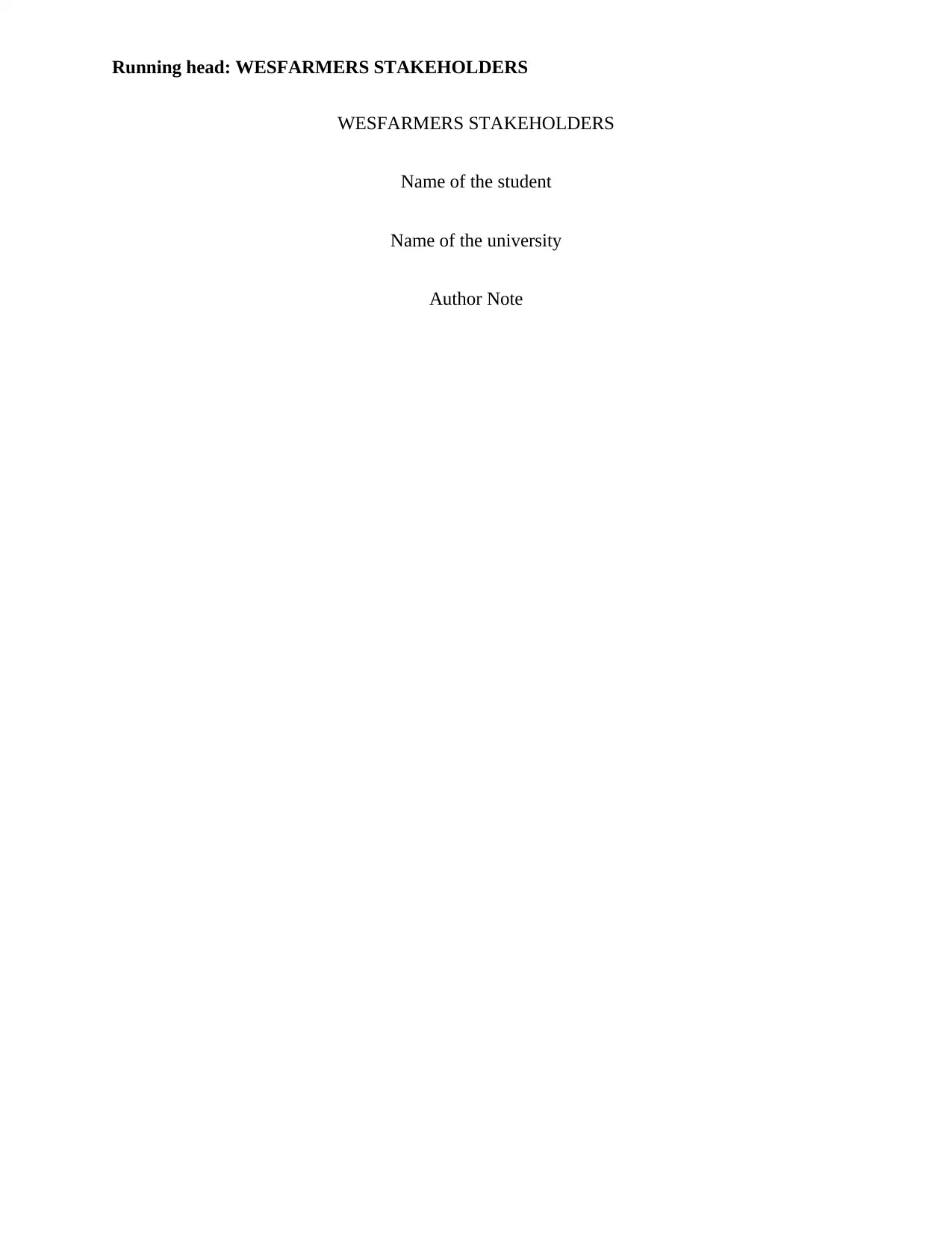
Running head: WESFARMERS STAKEHOLDERS
WESFARMERS STAKEHOLDERS
Name of the student
Name of the university
Author Note
WESFARMERS STAKEHOLDERS
Name of the student
Name of the university
Author Note
Secure Best Marks with AI Grader
Need help grading? Try our AI Grader for instant feedback on your assignments.
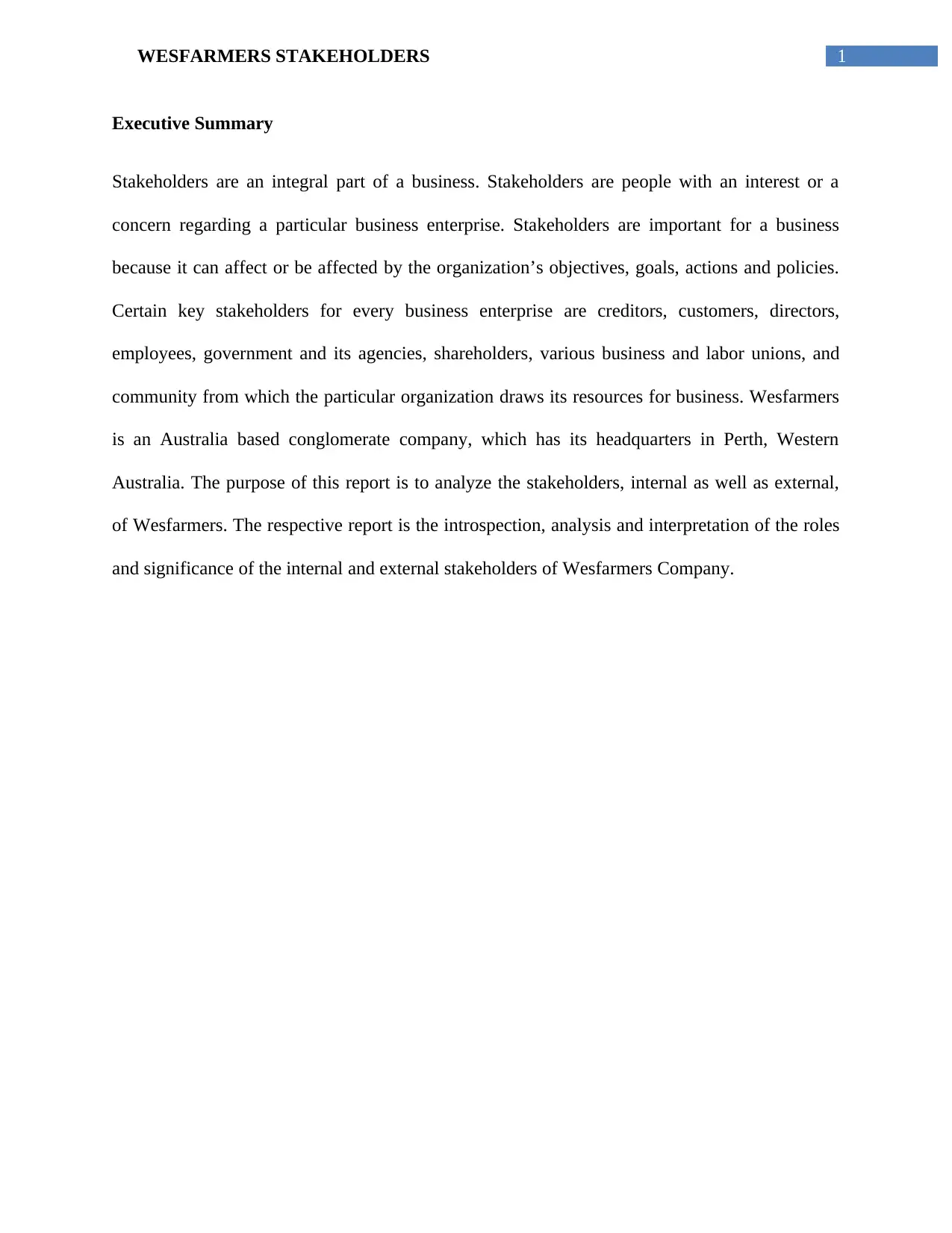
1WESFARMERS STAKEHOLDERS
Executive Summary
Stakeholders are an integral part of a business. Stakeholders are people with an interest or a
concern regarding a particular business enterprise. Stakeholders are important for a business
because it can affect or be affected by the organization’s objectives, goals, actions and policies.
Certain key stakeholders for every business enterprise are creditors, customers, directors,
employees, government and its agencies, shareholders, various business and labor unions, and
community from which the particular organization draws its resources for business. Wesfarmers
is an Australia based conglomerate company, which has its headquarters in Perth, Western
Australia. The purpose of this report is to analyze the stakeholders, internal as well as external,
of Wesfarmers. The respective report is the introspection, analysis and interpretation of the roles
and significance of the internal and external stakeholders of Wesfarmers Company.
Executive Summary
Stakeholders are an integral part of a business. Stakeholders are people with an interest or a
concern regarding a particular business enterprise. Stakeholders are important for a business
because it can affect or be affected by the organization’s objectives, goals, actions and policies.
Certain key stakeholders for every business enterprise are creditors, customers, directors,
employees, government and its agencies, shareholders, various business and labor unions, and
community from which the particular organization draws its resources for business. Wesfarmers
is an Australia based conglomerate company, which has its headquarters in Perth, Western
Australia. The purpose of this report is to analyze the stakeholders, internal as well as external,
of Wesfarmers. The respective report is the introspection, analysis and interpretation of the roles
and significance of the internal and external stakeholders of Wesfarmers Company.

2WESFARMERS STAKEHOLDERS
Table of Contents
Executive Summary.........................................................................................................................1
Introduction......................................................................................................................................3
Discussion........................................................................................................................................3
Company Overview.....................................................................................................................3
Functional Area of the Company.................................................................................................4
Key Stakeholders.........................................................................................................................4
Analysis of the internal stakeholders...............................................................................................5
Employees....................................................................................................................................6
Managers......................................................................................................................................6
Investors.......................................................................................................................................7
Board members............................................................................................................................7
Analysis of the external stakeholders..............................................................................................8
Customers....................................................................................................................................8
Suppliers......................................................................................................................................8
Implications of the conflicting interests..........................................................................................8
Influence level of the stakeholders................................................................................................10
Comparison with hospitality sector...............................................................................................11
Conclusion.....................................................................................................................................12
Reference.......................................................................................................................................13
Table of Contents
Executive Summary.........................................................................................................................1
Introduction......................................................................................................................................3
Discussion........................................................................................................................................3
Company Overview.....................................................................................................................3
Functional Area of the Company.................................................................................................4
Key Stakeholders.........................................................................................................................4
Analysis of the internal stakeholders...............................................................................................5
Employees....................................................................................................................................6
Managers......................................................................................................................................6
Investors.......................................................................................................................................7
Board members............................................................................................................................7
Analysis of the external stakeholders..............................................................................................8
Customers....................................................................................................................................8
Suppliers......................................................................................................................................8
Implications of the conflicting interests..........................................................................................8
Influence level of the stakeholders................................................................................................10
Comparison with hospitality sector...............................................................................................11
Conclusion.....................................................................................................................................12
Reference.......................................................................................................................................13
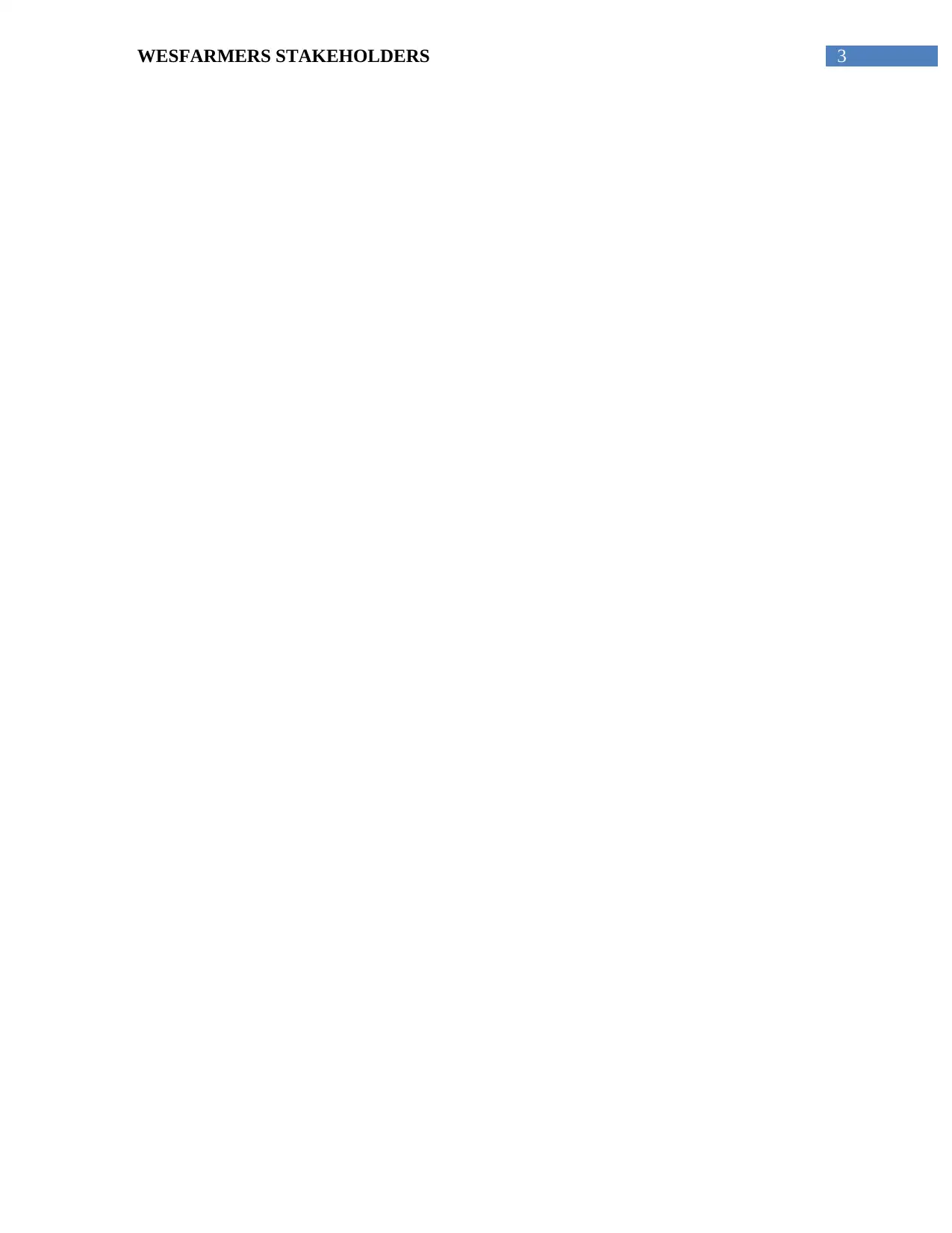
3WESFARMERS STAKEHOLDERS
Secure Best Marks with AI Grader
Need help grading? Try our AI Grader for instant feedback on your assignments.

4WESFARMERS STAKEHOLDERS
Introduction
Stakeholders are an integral part of a business. Stakeholders are people with an interest or
a concern regarding a particular business enterprise. Stakeholders are important for a business
because it can affect or be affected by the organization’s objectives, goals, actions and policies.
Certain key stakeholders for every business enterprise are creditors, customers, directors,
employees, government and its agencies, shareholders, various business and labor unions, and
community from which the particular organization draws its resources for business. Stakeholders
can be classified into two categories, mainly, internal as well as external stakeholders. The
internal stakeholders are the people who are directly involved with the business of the enterprise,
for instance, owners, board members, managerial heads, employees and professionals (Missonier
& Loufrani-Fedida, 2014). Whereas, external stakeholders are the people who are indirectly
manipulated or influenced by the happenings of the business enterprise, for instance, customers,
unions, society and government. Wesfarmers is an Australia based conglomerate company,
which has its headquarters in Perth, Western Australia. The purpose of this report is to analyze
the stakeholders, internal as well as external, of Wesfarmers. The respective report is the
introspection, analysis and interpretation of the roles and significance of the internal and external
stakeholders of Wesfarmers Company (Bourne, 2016).
Discussion
Company Overview
Wesfarmers Limited is a conglomerate company based on Australia which is
headquartered in the city of Perth, Western Australia. The company is mainly interested in the
field of retails, chemicals, fertilizers, coal mining, industrial products and safety products which
Introduction
Stakeholders are an integral part of a business. Stakeholders are people with an interest or
a concern regarding a particular business enterprise. Stakeholders are important for a business
because it can affect or be affected by the organization’s objectives, goals, actions and policies.
Certain key stakeholders for every business enterprise are creditors, customers, directors,
employees, government and its agencies, shareholders, various business and labor unions, and
community from which the particular organization draws its resources for business. Stakeholders
can be classified into two categories, mainly, internal as well as external stakeholders. The
internal stakeholders are the people who are directly involved with the business of the enterprise,
for instance, owners, board members, managerial heads, employees and professionals (Missonier
& Loufrani-Fedida, 2014). Whereas, external stakeholders are the people who are indirectly
manipulated or influenced by the happenings of the business enterprise, for instance, customers,
unions, society and government. Wesfarmers is an Australia based conglomerate company,
which has its headquarters in Perth, Western Australia. The purpose of this report is to analyze
the stakeholders, internal as well as external, of Wesfarmers. The respective report is the
introspection, analysis and interpretation of the roles and significance of the internal and external
stakeholders of Wesfarmers Company (Bourne, 2016).
Discussion
Company Overview
Wesfarmers Limited is a conglomerate company based on Australia which is
headquartered in the city of Perth, Western Australia. The company is mainly interested in the
field of retails, chemicals, fertilizers, coal mining, industrial products and safety products which
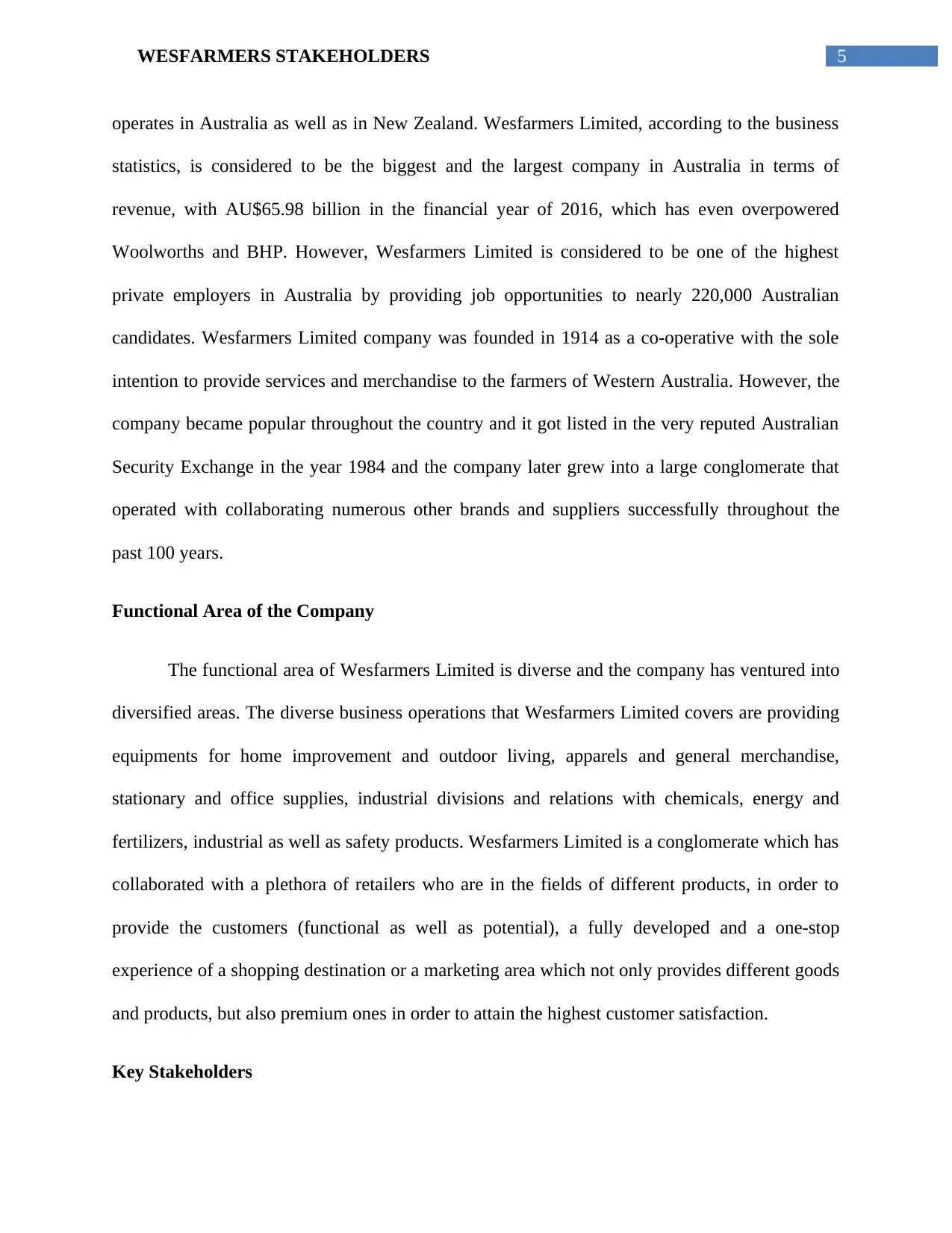
5WESFARMERS STAKEHOLDERS
operates in Australia as well as in New Zealand. Wesfarmers Limited, according to the business
statistics, is considered to be the biggest and the largest company in Australia in terms of
revenue, with AU$65.98 billion in the financial year of 2016, which has even overpowered
Woolworths and BHP. However, Wesfarmers Limited is considered to be one of the highest
private employers in Australia by providing job opportunities to nearly 220,000 Australian
candidates. Wesfarmers Limited company was founded in 1914 as a co-operative with the sole
intention to provide services and merchandise to the farmers of Western Australia. However, the
company became popular throughout the country and it got listed in the very reputed Australian
Security Exchange in the year 1984 and the company later grew into a large conglomerate that
operated with collaborating numerous other brands and suppliers successfully throughout the
past 100 years.
Functional Area of the Company
The functional area of Wesfarmers Limited is diverse and the company has ventured into
diversified areas. The diverse business operations that Wesfarmers Limited covers are providing
equipments for home improvement and outdoor living, apparels and general merchandise,
stationary and office supplies, industrial divisions and relations with chemicals, energy and
fertilizers, industrial as well as safety products. Wesfarmers Limited is a conglomerate which has
collaborated with a plethora of retailers who are in the fields of different products, in order to
provide the customers (functional as well as potential), a fully developed and a one-stop
experience of a shopping destination or a marketing area which not only provides different goods
and products, but also premium ones in order to attain the highest customer satisfaction.
Key Stakeholders
operates in Australia as well as in New Zealand. Wesfarmers Limited, according to the business
statistics, is considered to be the biggest and the largest company in Australia in terms of
revenue, with AU$65.98 billion in the financial year of 2016, which has even overpowered
Woolworths and BHP. However, Wesfarmers Limited is considered to be one of the highest
private employers in Australia by providing job opportunities to nearly 220,000 Australian
candidates. Wesfarmers Limited company was founded in 1914 as a co-operative with the sole
intention to provide services and merchandise to the farmers of Western Australia. However, the
company became popular throughout the country and it got listed in the very reputed Australian
Security Exchange in the year 1984 and the company later grew into a large conglomerate that
operated with collaborating numerous other brands and suppliers successfully throughout the
past 100 years.
Functional Area of the Company
The functional area of Wesfarmers Limited is diverse and the company has ventured into
diversified areas. The diverse business operations that Wesfarmers Limited covers are providing
equipments for home improvement and outdoor living, apparels and general merchandise,
stationary and office supplies, industrial divisions and relations with chemicals, energy and
fertilizers, industrial as well as safety products. Wesfarmers Limited is a conglomerate which has
collaborated with a plethora of retailers who are in the fields of different products, in order to
provide the customers (functional as well as potential), a fully developed and a one-stop
experience of a shopping destination or a marketing area which not only provides different goods
and products, but also premium ones in order to attain the highest customer satisfaction.
Key Stakeholders
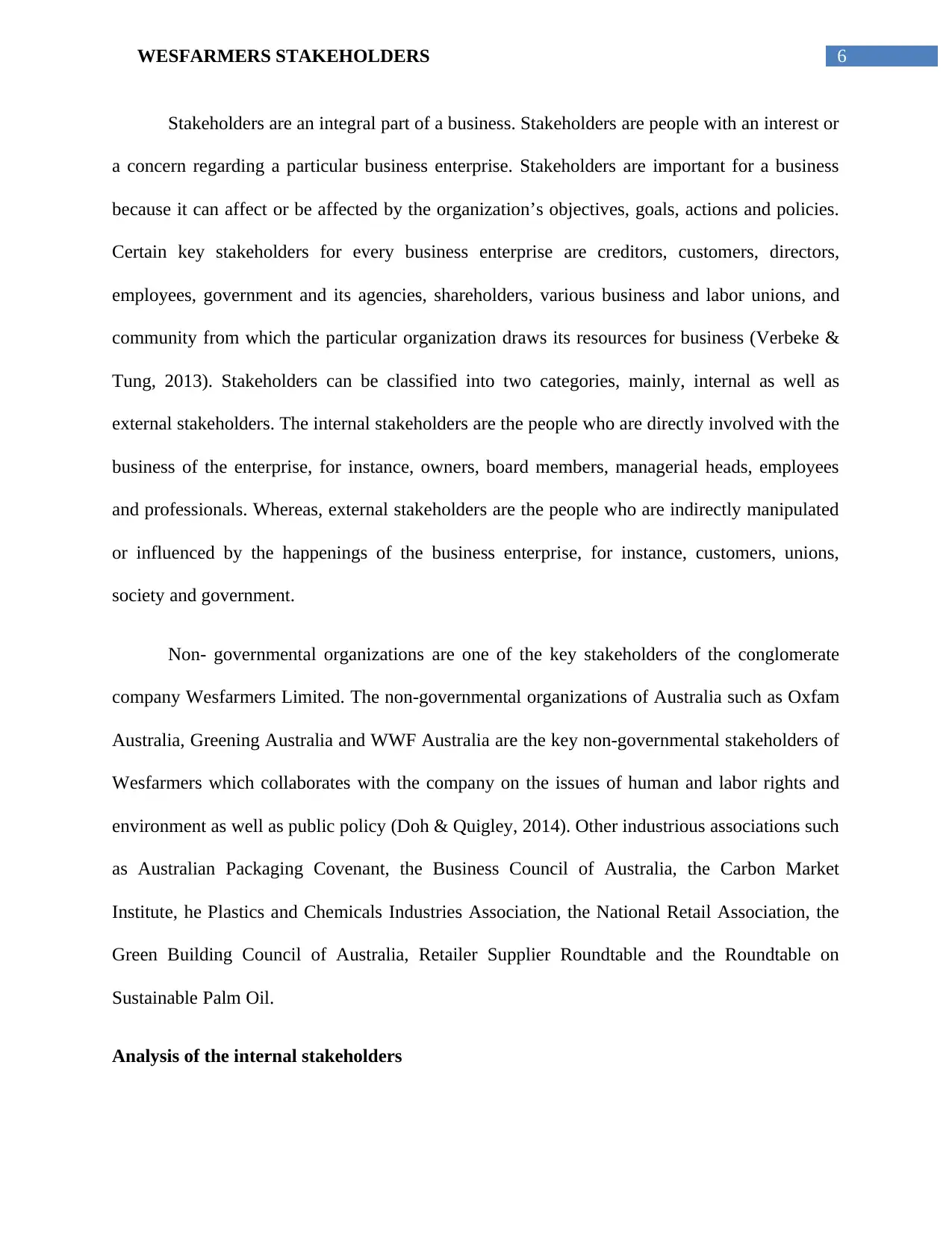
6WESFARMERS STAKEHOLDERS
Stakeholders are an integral part of a business. Stakeholders are people with an interest or
a concern regarding a particular business enterprise. Stakeholders are important for a business
because it can affect or be affected by the organization’s objectives, goals, actions and policies.
Certain key stakeholders for every business enterprise are creditors, customers, directors,
employees, government and its agencies, shareholders, various business and labor unions, and
community from which the particular organization draws its resources for business (Verbeke &
Tung, 2013). Stakeholders can be classified into two categories, mainly, internal as well as
external stakeholders. The internal stakeholders are the people who are directly involved with the
business of the enterprise, for instance, owners, board members, managerial heads, employees
and professionals. Whereas, external stakeholders are the people who are indirectly manipulated
or influenced by the happenings of the business enterprise, for instance, customers, unions,
society and government.
Non- governmental organizations are one of the key stakeholders of the conglomerate
company Wesfarmers Limited. The non-governmental organizations of Australia such as Oxfam
Australia, Greening Australia and WWF Australia are the key non-governmental stakeholders of
Wesfarmers which collaborates with the company on the issues of human and labor rights and
environment as well as public policy (Doh & Quigley, 2014). Other industrious associations such
as Australian Packaging Covenant, the Business Council of Australia, the Carbon Market
Institute, he Plastics and Chemicals Industries Association, the National Retail Association, the
Green Building Council of Australia, Retailer Supplier Roundtable and the Roundtable on
Sustainable Palm Oil.
Analysis of the internal stakeholders
Stakeholders are an integral part of a business. Stakeholders are people with an interest or
a concern regarding a particular business enterprise. Stakeholders are important for a business
because it can affect or be affected by the organization’s objectives, goals, actions and policies.
Certain key stakeholders for every business enterprise are creditors, customers, directors,
employees, government and its agencies, shareholders, various business and labor unions, and
community from which the particular organization draws its resources for business (Verbeke &
Tung, 2013). Stakeholders can be classified into two categories, mainly, internal as well as
external stakeholders. The internal stakeholders are the people who are directly involved with the
business of the enterprise, for instance, owners, board members, managerial heads, employees
and professionals. Whereas, external stakeholders are the people who are indirectly manipulated
or influenced by the happenings of the business enterprise, for instance, customers, unions,
society and government.
Non- governmental organizations are one of the key stakeholders of the conglomerate
company Wesfarmers Limited. The non-governmental organizations of Australia such as Oxfam
Australia, Greening Australia and WWF Australia are the key non-governmental stakeholders of
Wesfarmers which collaborates with the company on the issues of human and labor rights and
environment as well as public policy (Doh & Quigley, 2014). Other industrious associations such
as Australian Packaging Covenant, the Business Council of Australia, the Carbon Market
Institute, he Plastics and Chemicals Industries Association, the National Retail Association, the
Green Building Council of Australia, Retailer Supplier Roundtable and the Roundtable on
Sustainable Palm Oil.
Analysis of the internal stakeholders
Paraphrase This Document
Need a fresh take? Get an instant paraphrase of this document with our AI Paraphraser
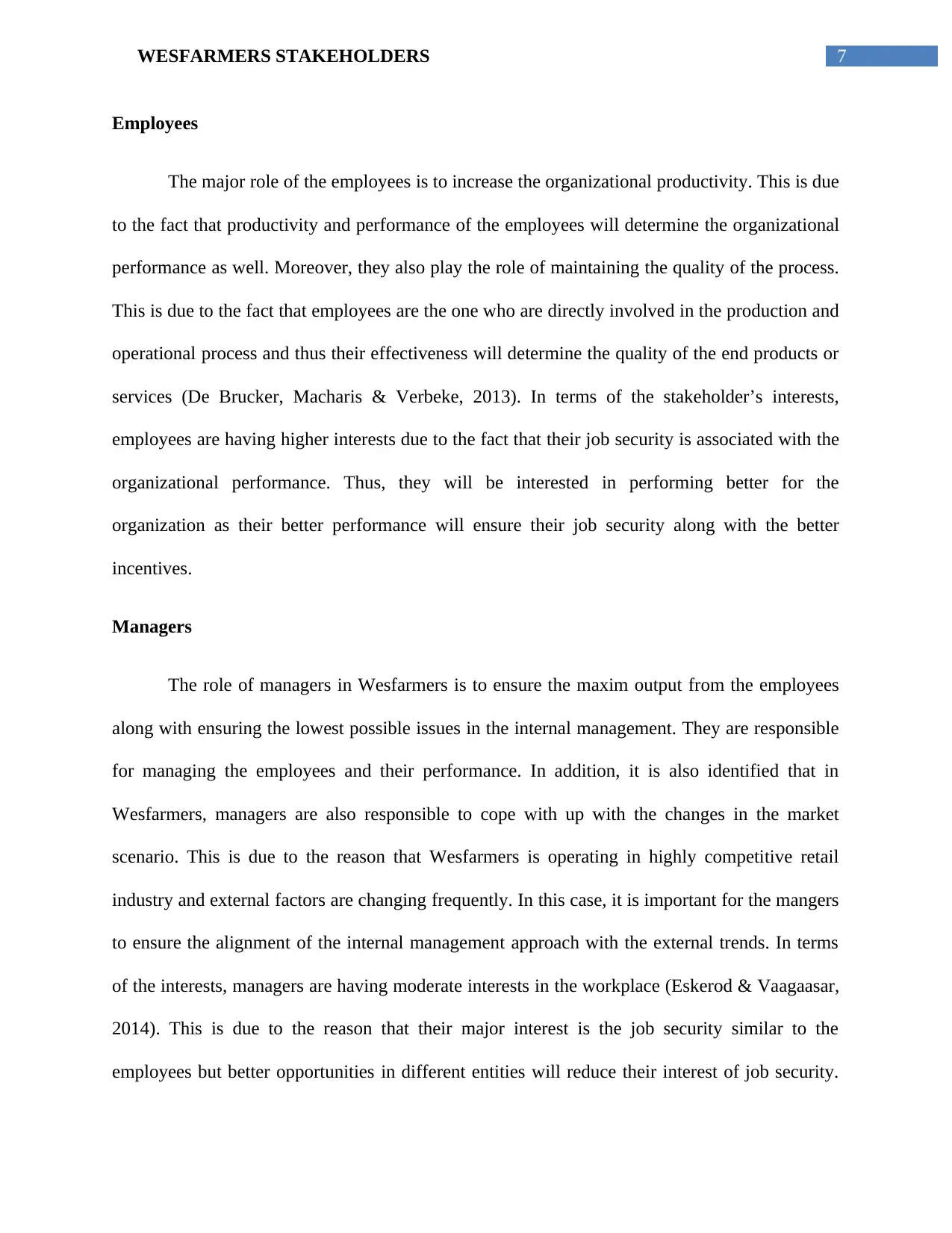
7WESFARMERS STAKEHOLDERS
Employees
The major role of the employees is to increase the organizational productivity. This is due
to the fact that productivity and performance of the employees will determine the organizational
performance as well. Moreover, they also play the role of maintaining the quality of the process.
This is due to the fact that employees are the one who are directly involved in the production and
operational process and thus their effectiveness will determine the quality of the end products or
services (De Brucker, Macharis & Verbeke, 2013). In terms of the stakeholder’s interests,
employees are having higher interests due to the fact that their job security is associated with the
organizational performance. Thus, they will be interested in performing better for the
organization as their better performance will ensure their job security along with the better
incentives.
Managers
The role of managers in Wesfarmers is to ensure the maxim output from the employees
along with ensuring the lowest possible issues in the internal management. They are responsible
for managing the employees and their performance. In addition, it is also identified that in
Wesfarmers, managers are also responsible to cope with up with the changes in the market
scenario. This is due to the reason that Wesfarmers is operating in highly competitive retail
industry and external factors are changing frequently. In this case, it is important for the mangers
to ensure the alignment of the internal management approach with the external trends. In terms
of the interests, managers are having moderate interests in the workplace (Eskerod & Vaagaasar,
2014). This is due to the reason that their major interest is the job security similar to the
employees but better opportunities in different entities will reduce their interest of job security.
Employees
The major role of the employees is to increase the organizational productivity. This is due
to the fact that productivity and performance of the employees will determine the organizational
performance as well. Moreover, they also play the role of maintaining the quality of the process.
This is due to the fact that employees are the one who are directly involved in the production and
operational process and thus their effectiveness will determine the quality of the end products or
services (De Brucker, Macharis & Verbeke, 2013). In terms of the stakeholder’s interests,
employees are having higher interests due to the fact that their job security is associated with the
organizational performance. Thus, they will be interested in performing better for the
organization as their better performance will ensure their job security along with the better
incentives.
Managers
The role of managers in Wesfarmers is to ensure the maxim output from the employees
along with ensuring the lowest possible issues in the internal management. They are responsible
for managing the employees and their performance. In addition, it is also identified that in
Wesfarmers, managers are also responsible to cope with up with the changes in the market
scenario. This is due to the reason that Wesfarmers is operating in highly competitive retail
industry and external factors are changing frequently. In this case, it is important for the mangers
to ensure the alignment of the internal management approach with the external trends. In terms
of the interests, managers are having moderate interests in the workplace (Eskerod & Vaagaasar,
2014). This is due to the reason that their major interest is the job security similar to the
employees but better opportunities in different entities will reduce their interest of job security.
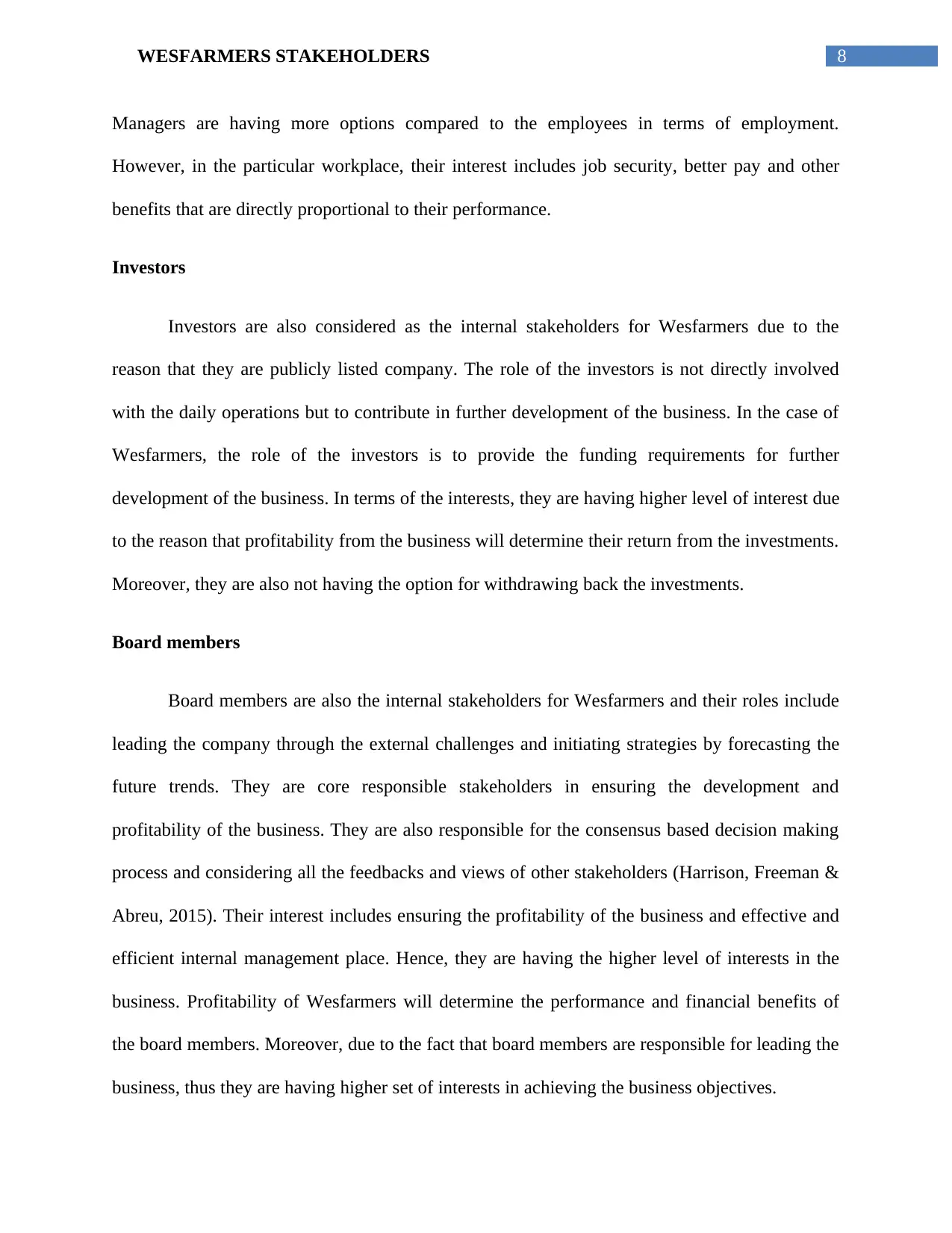
8WESFARMERS STAKEHOLDERS
Managers are having more options compared to the employees in terms of employment.
However, in the particular workplace, their interest includes job security, better pay and other
benefits that are directly proportional to their performance.
Investors
Investors are also considered as the internal stakeholders for Wesfarmers due to the
reason that they are publicly listed company. The role of the investors is not directly involved
with the daily operations but to contribute in further development of the business. In the case of
Wesfarmers, the role of the investors is to provide the funding requirements for further
development of the business. In terms of the interests, they are having higher level of interest due
to the reason that profitability from the business will determine their return from the investments.
Moreover, they are also not having the option for withdrawing back the investments.
Board members
Board members are also the internal stakeholders for Wesfarmers and their roles include
leading the company through the external challenges and initiating strategies by forecasting the
future trends. They are core responsible stakeholders in ensuring the development and
profitability of the business. They are also responsible for the consensus based decision making
process and considering all the feedbacks and views of other stakeholders (Harrison, Freeman &
Abreu, 2015). Their interest includes ensuring the profitability of the business and effective and
efficient internal management place. Hence, they are having the higher level of interests in the
business. Profitability of Wesfarmers will determine the performance and financial benefits of
the board members. Moreover, due to the fact that board members are responsible for leading the
business, thus they are having higher set of interests in achieving the business objectives.
Managers are having more options compared to the employees in terms of employment.
However, in the particular workplace, their interest includes job security, better pay and other
benefits that are directly proportional to their performance.
Investors
Investors are also considered as the internal stakeholders for Wesfarmers due to the
reason that they are publicly listed company. The role of the investors is not directly involved
with the daily operations but to contribute in further development of the business. In the case of
Wesfarmers, the role of the investors is to provide the funding requirements for further
development of the business. In terms of the interests, they are having higher level of interest due
to the reason that profitability from the business will determine their return from the investments.
Moreover, they are also not having the option for withdrawing back the investments.
Board members
Board members are also the internal stakeholders for Wesfarmers and their roles include
leading the company through the external challenges and initiating strategies by forecasting the
future trends. They are core responsible stakeholders in ensuring the development and
profitability of the business. They are also responsible for the consensus based decision making
process and considering all the feedbacks and views of other stakeholders (Harrison, Freeman &
Abreu, 2015). Their interest includes ensuring the profitability of the business and effective and
efficient internal management place. Hence, they are having the higher level of interests in the
business. Profitability of Wesfarmers will determine the performance and financial benefits of
the board members. Moreover, due to the fact that board members are responsible for leading the
business, thus they are having higher set of interests in achieving the business objectives.
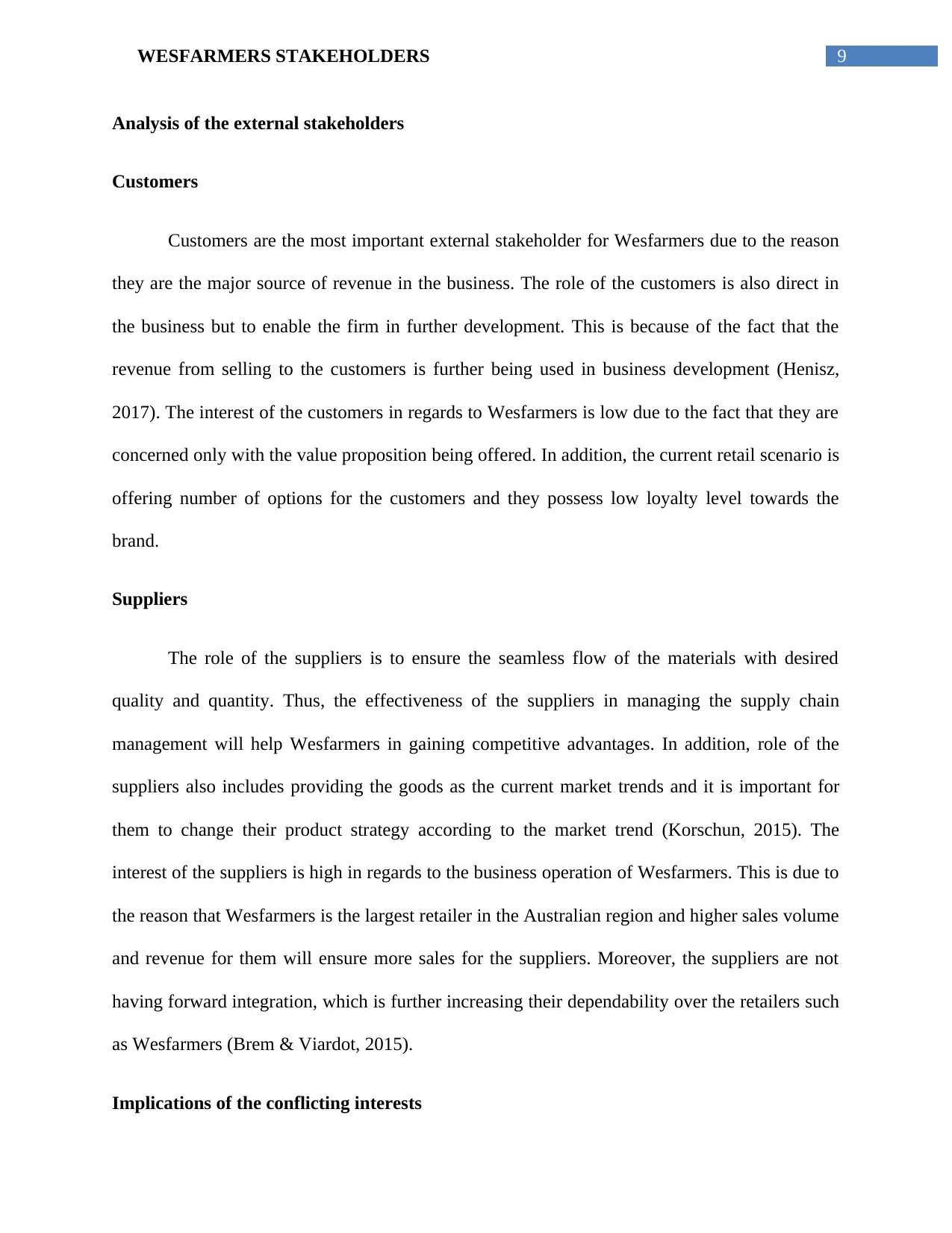
9WESFARMERS STAKEHOLDERS
Analysis of the external stakeholders
Customers
Customers are the most important external stakeholder for Wesfarmers due to the reason
they are the major source of revenue in the business. The role of the customers is also direct in
the business but to enable the firm in further development. This is because of the fact that the
revenue from selling to the customers is further being used in business development (Henisz,
2017). The interest of the customers in regards to Wesfarmers is low due to the fact that they are
concerned only with the value proposition being offered. In addition, the current retail scenario is
offering number of options for the customers and they possess low loyalty level towards the
brand.
Suppliers
The role of the suppliers is to ensure the seamless flow of the materials with desired
quality and quantity. Thus, the effectiveness of the suppliers in managing the supply chain
management will help Wesfarmers in gaining competitive advantages. In addition, role of the
suppliers also includes providing the goods as the current market trends and it is important for
them to change their product strategy according to the market trend (Korschun, 2015). The
interest of the suppliers is high in regards to the business operation of Wesfarmers. This is due to
the reason that Wesfarmers is the largest retailer in the Australian region and higher sales volume
and revenue for them will ensure more sales for the suppliers. Moreover, the suppliers are not
having forward integration, which is further increasing their dependability over the retailers such
as Wesfarmers (Brem & Viardot, 2015).
Implications of the conflicting interests
Analysis of the external stakeholders
Customers
Customers are the most important external stakeholder for Wesfarmers due to the reason
they are the major source of revenue in the business. The role of the customers is also direct in
the business but to enable the firm in further development. This is because of the fact that the
revenue from selling to the customers is further being used in business development (Henisz,
2017). The interest of the customers in regards to Wesfarmers is low due to the fact that they are
concerned only with the value proposition being offered. In addition, the current retail scenario is
offering number of options for the customers and they possess low loyalty level towards the
brand.
Suppliers
The role of the suppliers is to ensure the seamless flow of the materials with desired
quality and quantity. Thus, the effectiveness of the suppliers in managing the supply chain
management will help Wesfarmers in gaining competitive advantages. In addition, role of the
suppliers also includes providing the goods as the current market trends and it is important for
them to change their product strategy according to the market trend (Korschun, 2015). The
interest of the suppliers is high in regards to the business operation of Wesfarmers. This is due to
the reason that Wesfarmers is the largest retailer in the Australian region and higher sales volume
and revenue for them will ensure more sales for the suppliers. Moreover, the suppliers are not
having forward integration, which is further increasing their dependability over the retailers such
as Wesfarmers (Brem & Viardot, 2015).
Implications of the conflicting interests
Secure Best Marks with AI Grader
Need help grading? Try our AI Grader for instant feedback on your assignments.
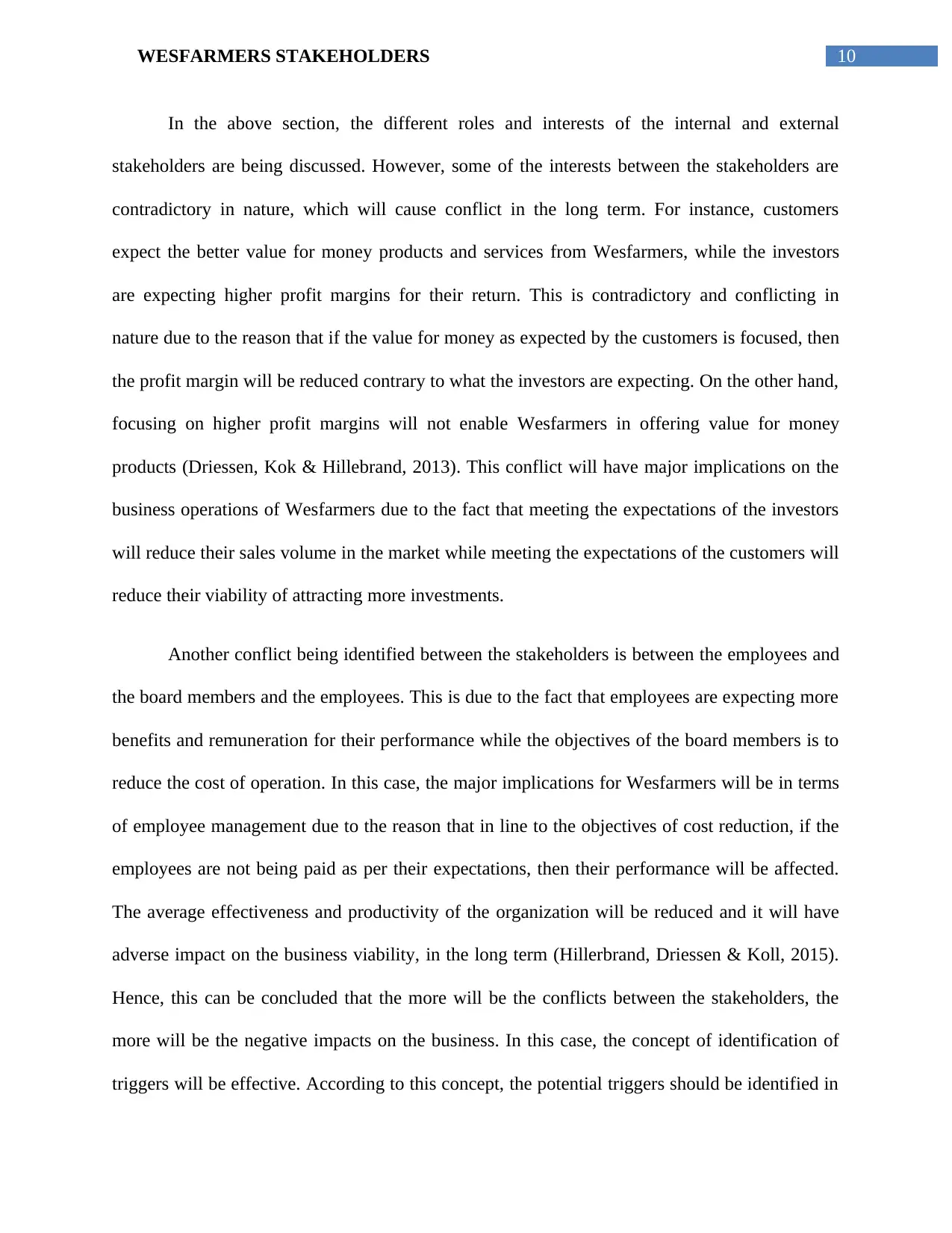
10WESFARMERS STAKEHOLDERS
In the above section, the different roles and interests of the internal and external
stakeholders are being discussed. However, some of the interests between the stakeholders are
contradictory in nature, which will cause conflict in the long term. For instance, customers
expect the better value for money products and services from Wesfarmers, while the investors
are expecting higher profit margins for their return. This is contradictory and conflicting in
nature due to the reason that if the value for money as expected by the customers is focused, then
the profit margin will be reduced contrary to what the investors are expecting. On the other hand,
focusing on higher profit margins will not enable Wesfarmers in offering value for money
products (Driessen, Kok & Hillebrand, 2013). This conflict will have major implications on the
business operations of Wesfarmers due to the fact that meeting the expectations of the investors
will reduce their sales volume in the market while meeting the expectations of the customers will
reduce their viability of attracting more investments.
Another conflict being identified between the stakeholders is between the employees and
the board members and the employees. This is due to the fact that employees are expecting more
benefits and remuneration for their performance while the objectives of the board members is to
reduce the cost of operation. In this case, the major implications for Wesfarmers will be in terms
of employee management due to the reason that in line to the objectives of cost reduction, if the
employees are not being paid as per their expectations, then their performance will be affected.
The average effectiveness and productivity of the organization will be reduced and it will have
adverse impact on the business viability, in the long term (Hillerbrand, Driessen & Koll, 2015).
Hence, this can be concluded that the more will be the conflicts between the stakeholders, the
more will be the negative impacts on the business. In this case, the concept of identification of
triggers will be effective. According to this concept, the potential triggers should be identified in
In the above section, the different roles and interests of the internal and external
stakeholders are being discussed. However, some of the interests between the stakeholders are
contradictory in nature, which will cause conflict in the long term. For instance, customers
expect the better value for money products and services from Wesfarmers, while the investors
are expecting higher profit margins for their return. This is contradictory and conflicting in
nature due to the reason that if the value for money as expected by the customers is focused, then
the profit margin will be reduced contrary to what the investors are expecting. On the other hand,
focusing on higher profit margins will not enable Wesfarmers in offering value for money
products (Driessen, Kok & Hillebrand, 2013). This conflict will have major implications on the
business operations of Wesfarmers due to the fact that meeting the expectations of the investors
will reduce their sales volume in the market while meeting the expectations of the customers will
reduce their viability of attracting more investments.
Another conflict being identified between the stakeholders is between the employees and
the board members and the employees. This is due to the fact that employees are expecting more
benefits and remuneration for their performance while the objectives of the board members is to
reduce the cost of operation. In this case, the major implications for Wesfarmers will be in terms
of employee management due to the reason that in line to the objectives of cost reduction, if the
employees are not being paid as per their expectations, then their performance will be affected.
The average effectiveness and productivity of the organization will be reduced and it will have
adverse impact on the business viability, in the long term (Hillerbrand, Driessen & Koll, 2015).
Hence, this can be concluded that the more will be the conflicts between the stakeholders, the
more will be the negative impacts on the business. In this case, the concept of identification of
triggers will be effective. According to this concept, the potential triggers should be identified in
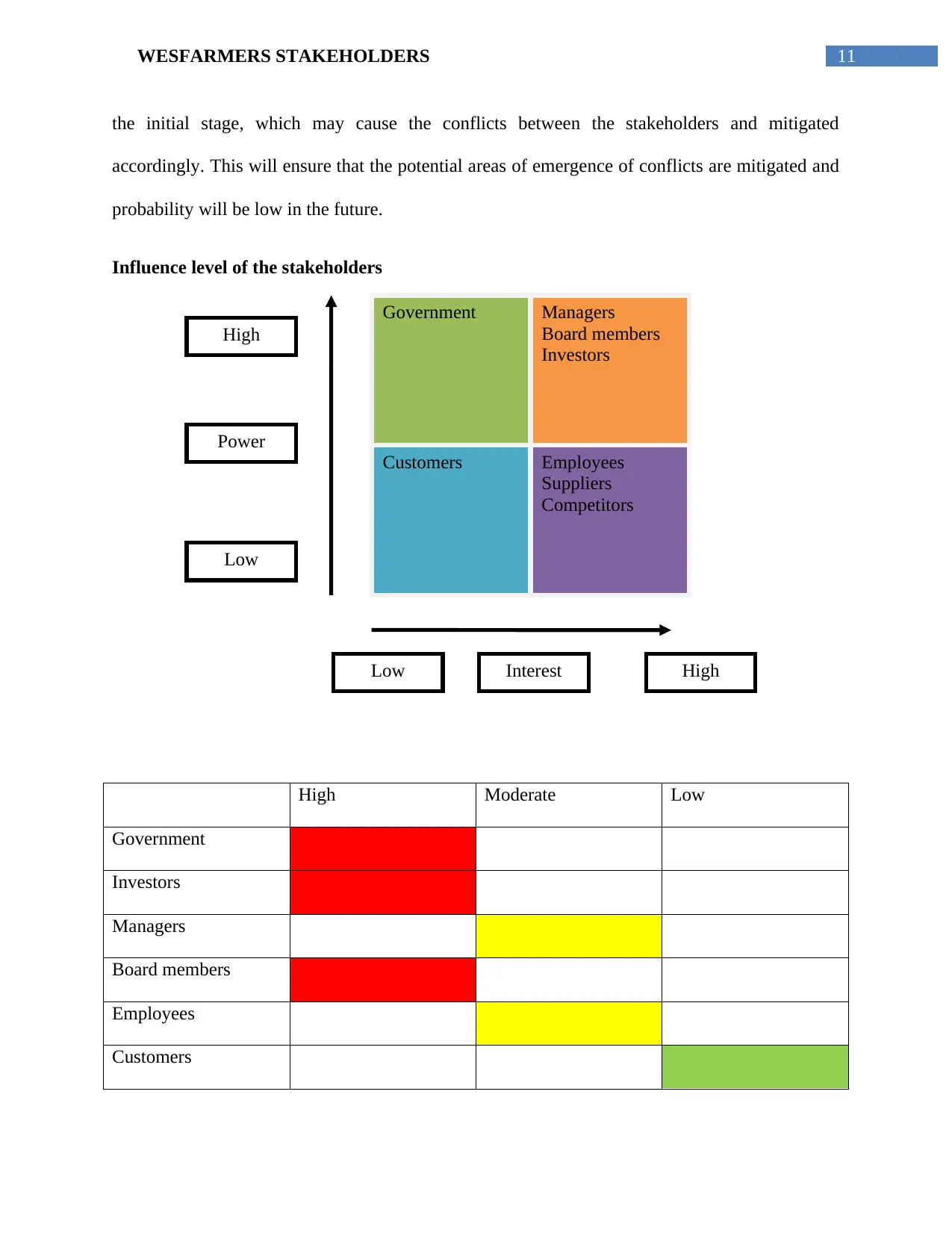
11WESFARMERS STAKEHOLDERS
Government
Customers Employees
Suppliers
Competitors
Managers
Board members
Investors
High
Power
Low
Low Interest High
the initial stage, which may cause the conflicts between the stakeholders and mitigated
accordingly. This will ensure that the potential areas of emergence of conflicts are mitigated and
probability will be low in the future.
Influence level of the stakeholders
High Moderate Low
Government
Investors
Managers
Board members
Employees
Customers
Government
Customers Employees
Suppliers
Competitors
Managers
Board members
Investors
High
Power
Low
Low Interest High
the initial stage, which may cause the conflicts between the stakeholders and mitigated
accordingly. This will ensure that the potential areas of emergence of conflicts are mitigated and
probability will be low in the future.
Influence level of the stakeholders
High Moderate Low
Government
Investors
Managers
Board members
Employees
Customers
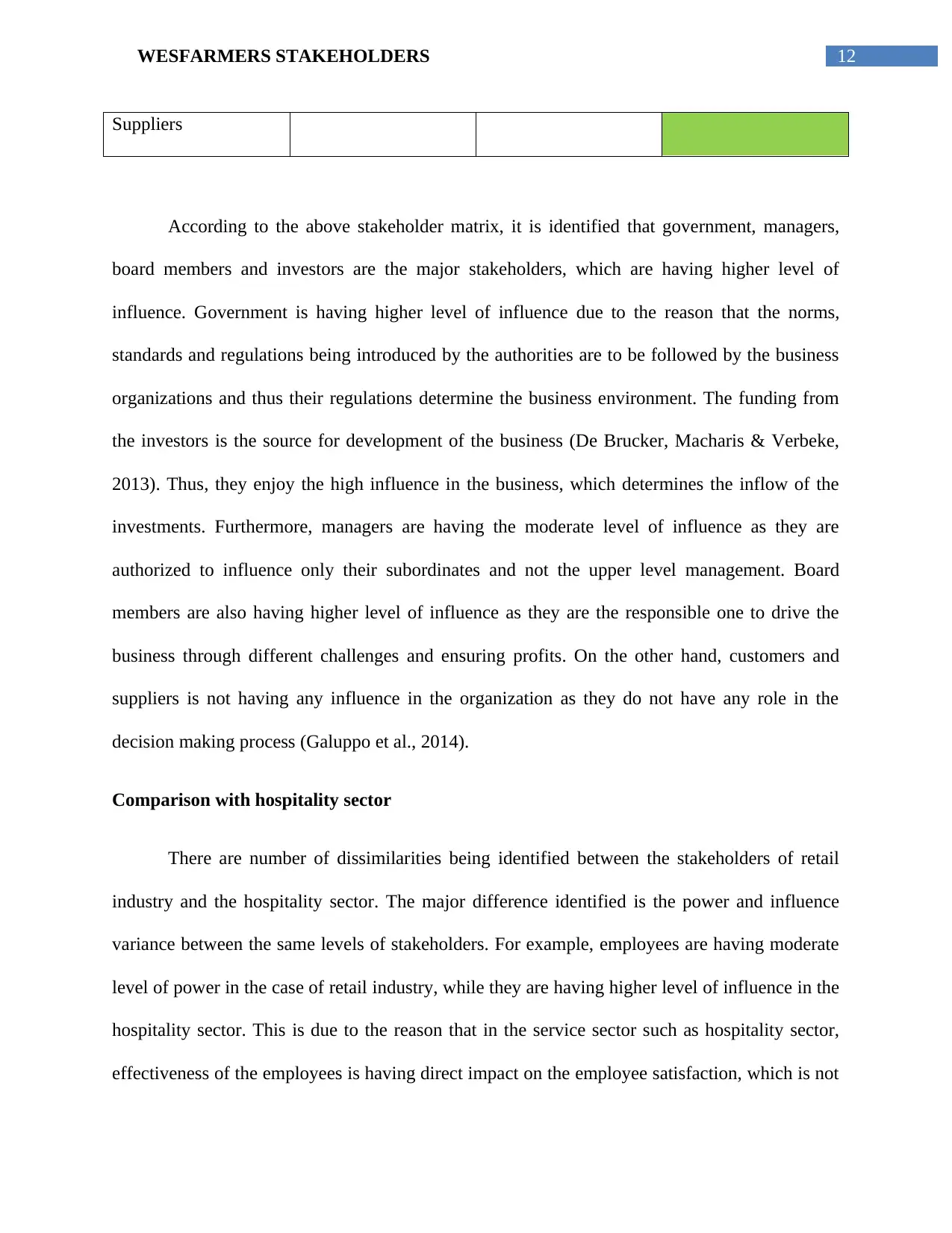
12WESFARMERS STAKEHOLDERS
Suppliers
According to the above stakeholder matrix, it is identified that government, managers,
board members and investors are the major stakeholders, which are having higher level of
influence. Government is having higher level of influence due to the reason that the norms,
standards and regulations being introduced by the authorities are to be followed by the business
organizations and thus their regulations determine the business environment. The funding from
the investors is the source for development of the business (De Brucker, Macharis & Verbeke,
2013). Thus, they enjoy the high influence in the business, which determines the inflow of the
investments. Furthermore, managers are having the moderate level of influence as they are
authorized to influence only their subordinates and not the upper level management. Board
members are also having higher level of influence as they are the responsible one to drive the
business through different challenges and ensuring profits. On the other hand, customers and
suppliers is not having any influence in the organization as they do not have any role in the
decision making process (Galuppo et al., 2014).
Comparison with hospitality sector
There are number of dissimilarities being identified between the stakeholders of retail
industry and the hospitality sector. The major difference identified is the power and influence
variance between the same levels of stakeholders. For example, employees are having moderate
level of power in the case of retail industry, while they are having higher level of influence in the
hospitality sector. This is due to the reason that in the service sector such as hospitality sector,
effectiveness of the employees is having direct impact on the employee satisfaction, which is not
Suppliers
According to the above stakeholder matrix, it is identified that government, managers,
board members and investors are the major stakeholders, which are having higher level of
influence. Government is having higher level of influence due to the reason that the norms,
standards and regulations being introduced by the authorities are to be followed by the business
organizations and thus their regulations determine the business environment. The funding from
the investors is the source for development of the business (De Brucker, Macharis & Verbeke,
2013). Thus, they enjoy the high influence in the business, which determines the inflow of the
investments. Furthermore, managers are having the moderate level of influence as they are
authorized to influence only their subordinates and not the upper level management. Board
members are also having higher level of influence as they are the responsible one to drive the
business through different challenges and ensuring profits. On the other hand, customers and
suppliers is not having any influence in the organization as they do not have any role in the
decision making process (Galuppo et al., 2014).
Comparison with hospitality sector
There are number of dissimilarities being identified between the stakeholders of retail
industry and the hospitality sector. The major difference identified is the power and influence
variance between the same levels of stakeholders. For example, employees are having moderate
level of power in the case of retail industry, while they are having higher level of influence in the
hospitality sector. This is due to the reason that in the service sector such as hospitality sector,
effectiveness of the employees is having direct impact on the employee satisfaction, which is not
Paraphrase This Document
Need a fresh take? Get an instant paraphrase of this document with our AI Paraphraser
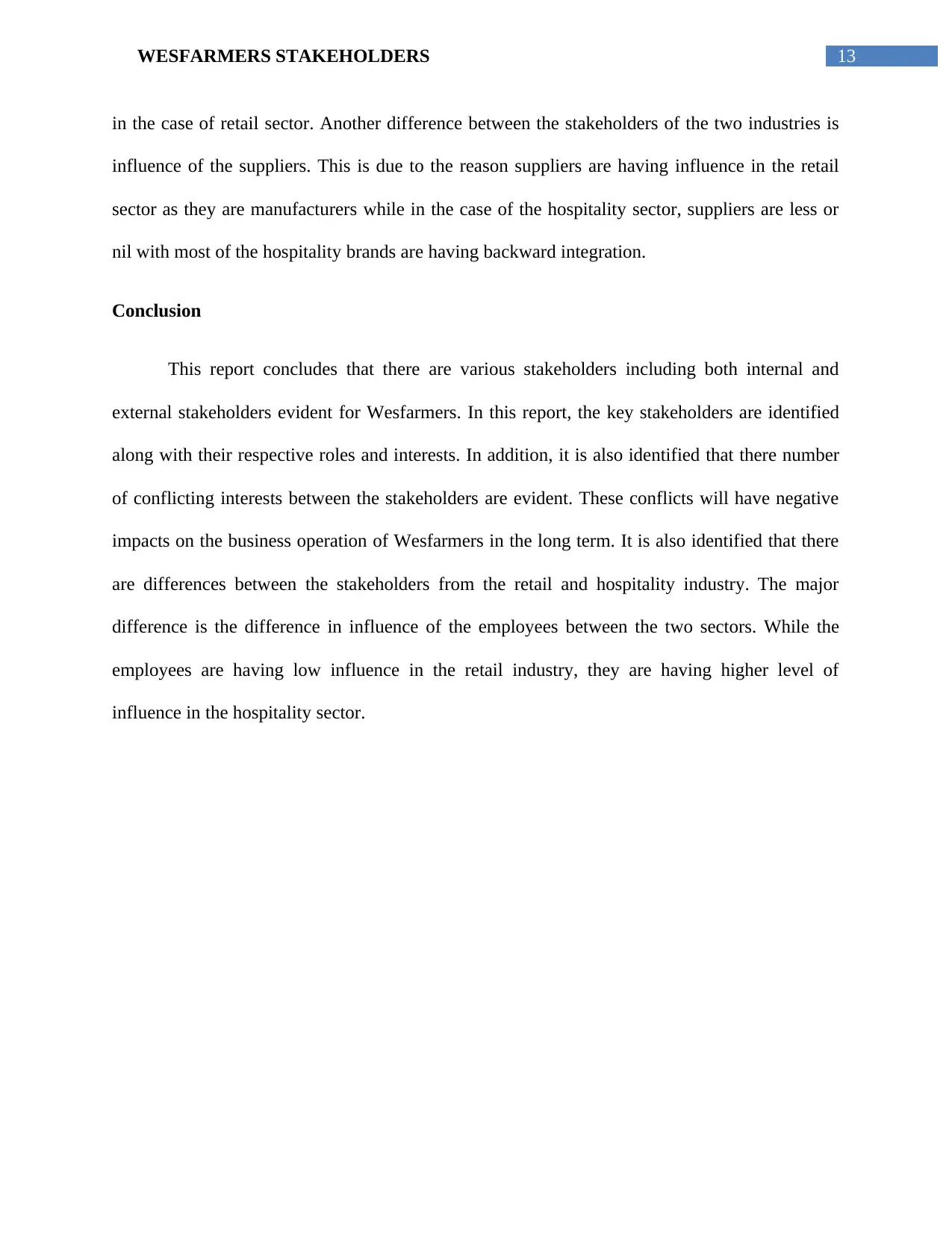
13WESFARMERS STAKEHOLDERS
in the case of retail sector. Another difference between the stakeholders of the two industries is
influence of the suppliers. This is due to the reason suppliers are having influence in the retail
sector as they are manufacturers while in the case of the hospitality sector, suppliers are less or
nil with most of the hospitality brands are having backward integration.
Conclusion
This report concludes that there are various stakeholders including both internal and
external stakeholders evident for Wesfarmers. In this report, the key stakeholders are identified
along with their respective roles and interests. In addition, it is also identified that there number
of conflicting interests between the stakeholders are evident. These conflicts will have negative
impacts on the business operation of Wesfarmers in the long term. It is also identified that there
are differences between the stakeholders from the retail and hospitality industry. The major
difference is the difference in influence of the employees between the two sectors. While the
employees are having low influence in the retail industry, they are having higher level of
influence in the hospitality sector.
in the case of retail sector. Another difference between the stakeholders of the two industries is
influence of the suppliers. This is due to the reason suppliers are having influence in the retail
sector as they are manufacturers while in the case of the hospitality sector, suppliers are less or
nil with most of the hospitality brands are having backward integration.
Conclusion
This report concludes that there are various stakeholders including both internal and
external stakeholders evident for Wesfarmers. In this report, the key stakeholders are identified
along with their respective roles and interests. In addition, it is also identified that there number
of conflicting interests between the stakeholders are evident. These conflicts will have negative
impacts on the business operation of Wesfarmers in the long term. It is also identified that there
are differences between the stakeholders from the retail and hospitality industry. The major
difference is the difference in influence of the employees between the two sectors. While the
employees are having low influence in the retail industry, they are having higher level of
influence in the hospitality sector.
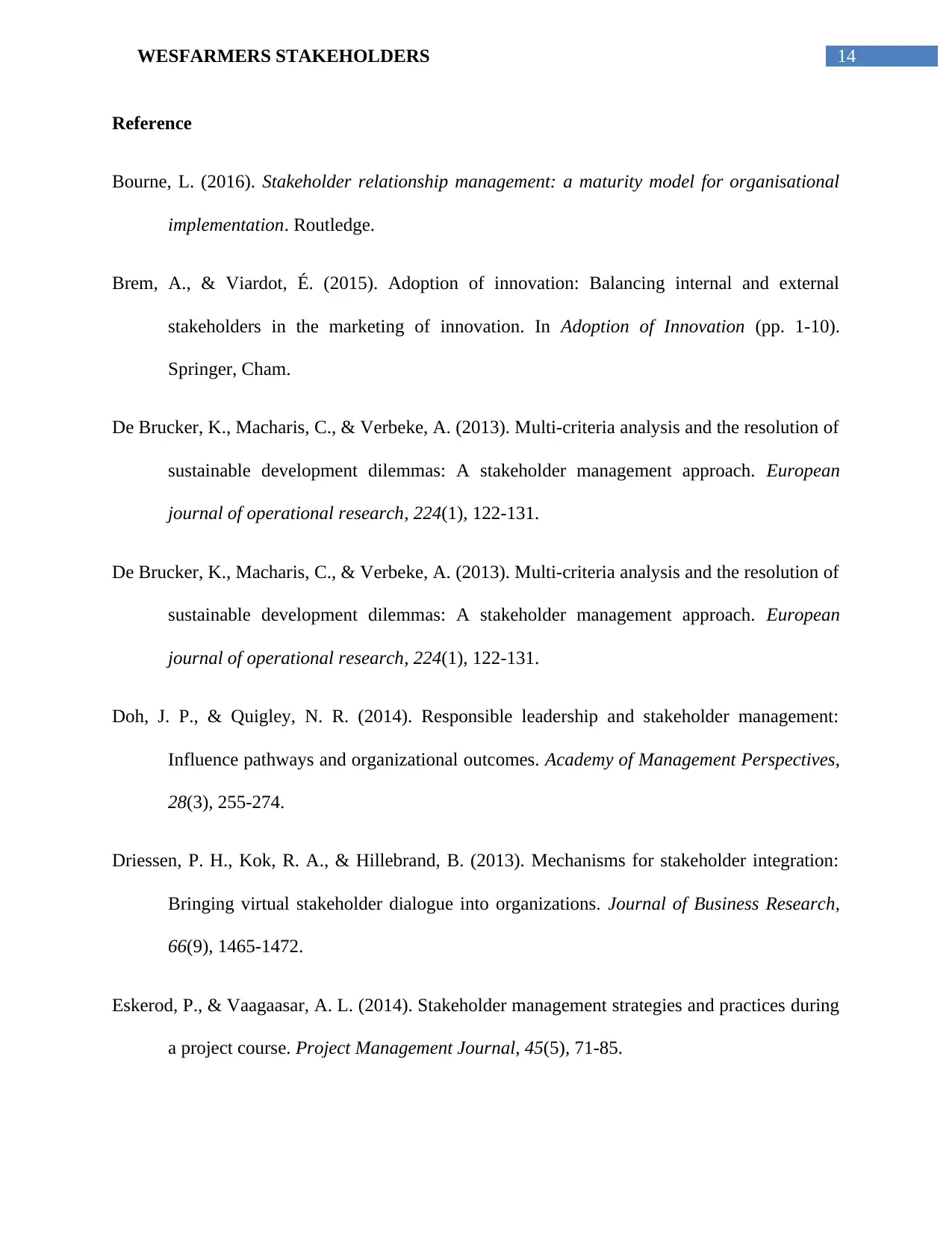
14WESFARMERS STAKEHOLDERS
Reference
Bourne, L. (2016). Stakeholder relationship management: a maturity model for organisational
implementation. Routledge.
Brem, A., & Viardot, É. (2015). Adoption of innovation: Balancing internal and external
stakeholders in the marketing of innovation. In Adoption of Innovation (pp. 1-10).
Springer, Cham.
De Brucker, K., Macharis, C., & Verbeke, A. (2013). Multi-criteria analysis and the resolution of
sustainable development dilemmas: A stakeholder management approach. European
journal of operational research, 224(1), 122-131.
De Brucker, K., Macharis, C., & Verbeke, A. (2013). Multi-criteria analysis and the resolution of
sustainable development dilemmas: A stakeholder management approach. European
journal of operational research, 224(1), 122-131.
Doh, J. P., & Quigley, N. R. (2014). Responsible leadership and stakeholder management:
Influence pathways and organizational outcomes. Academy of Management Perspectives,
28(3), 255-274.
Driessen, P. H., Kok, R. A., & Hillebrand, B. (2013). Mechanisms for stakeholder integration:
Bringing virtual stakeholder dialogue into organizations. Journal of Business Research,
66(9), 1465-1472.
Eskerod, P., & Vaagaasar, A. L. (2014). Stakeholder management strategies and practices during
a project course. Project Management Journal, 45(5), 71-85.
Reference
Bourne, L. (2016). Stakeholder relationship management: a maturity model for organisational
implementation. Routledge.
Brem, A., & Viardot, É. (2015). Adoption of innovation: Balancing internal and external
stakeholders in the marketing of innovation. In Adoption of Innovation (pp. 1-10).
Springer, Cham.
De Brucker, K., Macharis, C., & Verbeke, A. (2013). Multi-criteria analysis and the resolution of
sustainable development dilemmas: A stakeholder management approach. European
journal of operational research, 224(1), 122-131.
De Brucker, K., Macharis, C., & Verbeke, A. (2013). Multi-criteria analysis and the resolution of
sustainable development dilemmas: A stakeholder management approach. European
journal of operational research, 224(1), 122-131.
Doh, J. P., & Quigley, N. R. (2014). Responsible leadership and stakeholder management:
Influence pathways and organizational outcomes. Academy of Management Perspectives,
28(3), 255-274.
Driessen, P. H., Kok, R. A., & Hillebrand, B. (2013). Mechanisms for stakeholder integration:
Bringing virtual stakeholder dialogue into organizations. Journal of Business Research,
66(9), 1465-1472.
Eskerod, P., & Vaagaasar, A. L. (2014). Stakeholder management strategies and practices during
a project course. Project Management Journal, 45(5), 71-85.
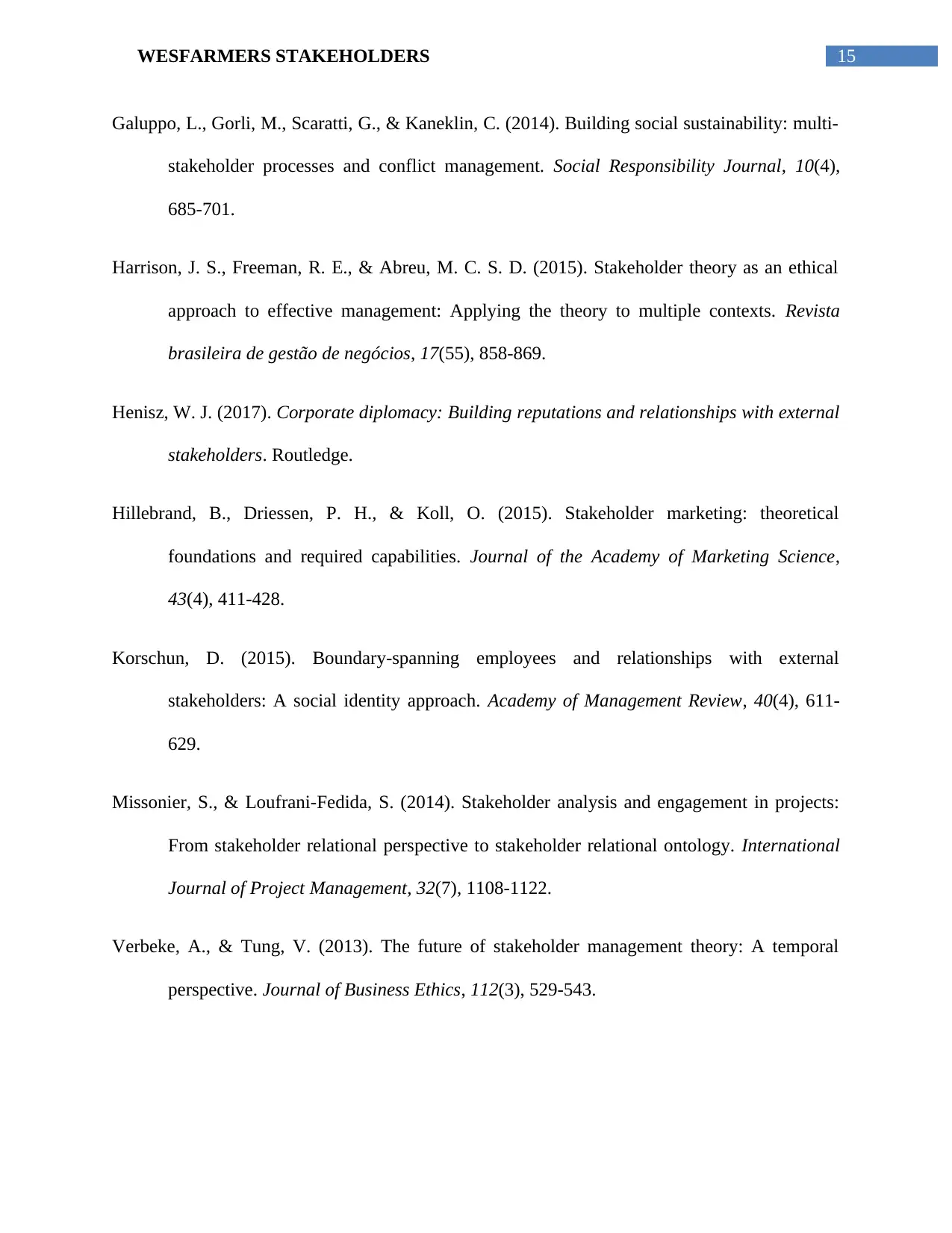
15WESFARMERS STAKEHOLDERS
Galuppo, L., Gorli, M., Scaratti, G., & Kaneklin, C. (2014). Building social sustainability: multi-
stakeholder processes and conflict management. Social Responsibility Journal, 10(4),
685-701.
Harrison, J. S., Freeman, R. E., & Abreu, M. C. S. D. (2015). Stakeholder theory as an ethical
approach to effective management: Applying the theory to multiple contexts. Revista
brasileira de gestão de negócios, 17(55), 858-869.
Henisz, W. J. (2017). Corporate diplomacy: Building reputations and relationships with external
stakeholders. Routledge.
Hillebrand, B., Driessen, P. H., & Koll, O. (2015). Stakeholder marketing: theoretical
foundations and required capabilities. Journal of the Academy of Marketing Science,
43(4), 411-428.
Korschun, D. (2015). Boundary-spanning employees and relationships with external
stakeholders: A social identity approach. Academy of Management Review, 40(4), 611-
629.
Missonier, S., & Loufrani-Fedida, S. (2014). Stakeholder analysis and engagement in projects:
From stakeholder relational perspective to stakeholder relational ontology. International
Journal of Project Management, 32(7), 1108-1122.
Verbeke, A., & Tung, V. (2013). The future of stakeholder management theory: A temporal
perspective. Journal of Business Ethics, 112(3), 529-543.
Galuppo, L., Gorli, M., Scaratti, G., & Kaneklin, C. (2014). Building social sustainability: multi-
stakeholder processes and conflict management. Social Responsibility Journal, 10(4),
685-701.
Harrison, J. S., Freeman, R. E., & Abreu, M. C. S. D. (2015). Stakeholder theory as an ethical
approach to effective management: Applying the theory to multiple contexts. Revista
brasileira de gestão de negócios, 17(55), 858-869.
Henisz, W. J. (2017). Corporate diplomacy: Building reputations and relationships with external
stakeholders. Routledge.
Hillebrand, B., Driessen, P. H., & Koll, O. (2015). Stakeholder marketing: theoretical
foundations and required capabilities. Journal of the Academy of Marketing Science,
43(4), 411-428.
Korschun, D. (2015). Boundary-spanning employees and relationships with external
stakeholders: A social identity approach. Academy of Management Review, 40(4), 611-
629.
Missonier, S., & Loufrani-Fedida, S. (2014). Stakeholder analysis and engagement in projects:
From stakeholder relational perspective to stakeholder relational ontology. International
Journal of Project Management, 32(7), 1108-1122.
Verbeke, A., & Tung, V. (2013). The future of stakeholder management theory: A temporal
perspective. Journal of Business Ethics, 112(3), 529-543.
1 out of 16
Related Documents
Your All-in-One AI-Powered Toolkit for Academic Success.
+13062052269
info@desklib.com
Available 24*7 on WhatsApp / Email
![[object Object]](/_next/static/media/star-bottom.7253800d.svg)
Unlock your academic potential
© 2024 | Zucol Services PVT LTD | All rights reserved.





